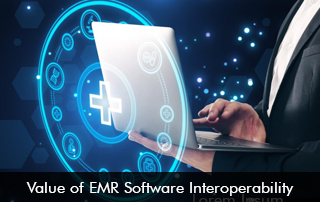Electronic Medical Records (EMR) Software interoperability is the cornerstone to enhance patient care and safety levels. EHR Software vendors and healthcare organizations understand the value of interoperability with EMR systems, according to the ONC data brief 70% of hospitals participate in interoperability however data exchange gaps continue.
EMR Software interoperability is growing across non-federal acute care hospitals making way for smooth data exchange. However long-term care and behavioral health providers are lagging when it comes to an interoperable environment.
What is EHR Software Interoperability?
The capacity of various Electronic Health Records Software systems and other health IT systems to interchange, understand, and use shared data without difficulty is known as EMR Software interoperability. Interoperability guarantees that the data retains its integrity and meaning, patient data may travel across different healthcare settings, including labs, pharmacies, hospitals, and even state or national boundaries.
Benefits of Electronic Medical Records Software Interoperability
An interoperable healthcare environment can ensure seamless and secure data transfer and sharing between different systems. EMR Software technology that has robust interoperability options has the following advantages:
Enhanced Patient Care
The prime goal of providers is to improve patient care to boost health outcomes. Interoperable EMR Software empowers clinicians to have accurate and up-to-date patient data at the point of care to support their decision-making process. Holistic and coordinated care can be provided to patients ultimately lowering any chances of errors.
Improve Workflows Efficiency
Duplicate testing and processes are less necessary when EHR software is interoperable. This results in effective healthcare delivery by saving time and resources for both patients and providers.
Better Public Health Reporting
Software interoperability can enhance public health reporting by facilitating accurate and seamless data transmission between various healthcare systems. This makes it possible to promptly aggregate health data from many sources, enabling thorough and instantaneous trend monitoring of public health. Tracking disease outbreaks, tracing the spread of diseases, and analyzing health outcomes across populations are all made easier with improved interoperability. Public health professionals can now respond to any public health emergencies effectively.
Patient Engagement with EHR Software Interoperability
Focusing on patient engagement not only boosts patient satisfaction scores but also has a positive impact on health outcomes. Engaged patients are more informed and driven to follow healthcare plans and medication as prescribed by their providers. EMR Software interoperability can foster an environment of patient empowerment by making health information more accessible and transparent.
Electronic Health Records Software interoperability ensures that patients have access to comprehensive health records like lab results, treatment histories, etc. The accurate availability of patient data can stimulate patients to make informed decisions about their health as they are more involved. Interoperable systems also make it easier for patients and healthcare professionals to communicate. Patients can now easily exchange health information with one another during consultations or while getting second opinions.
Moving Ahead
Through seamless information sharing, an interconnected environment can be built which is vital to improving care quality and patient safety. Routine EHR Software interoperability leads to empowered decision-making and leads to a coordinated care experience.







